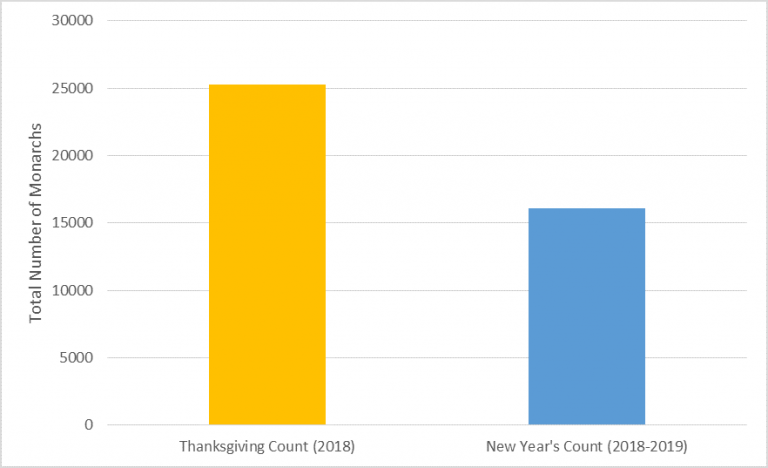Overall, the count data revealed an average decrease of 38% between the Thanksgiving and New Year’s counts.
This year’s Western Monarch Thanksgiving Count (WMTC) revealed critically low numbers of monarchs. In the 1980s, there were an estimated 4.5 million monarchs overwintering in California. Over Thanksgiving 2018, the population was counted at 28,429 monarchs—just 0.6% of the historic population and below the projected threshold for collapse of the western monarch migration.
Thanksgiving 2018 was the twenty-second season of the WMTC and volunteers counted at over 200 overwintering sites during a three-week period around Thanksgiving. This massive volunteer effort plays a vital role in tracking the size of the California overwintering population, which allows us to assess the health of the monarch population in western North America.
In an effort to better understand how monarchs use overwintering sites during the season, the Xerces Society initiated the Western Monarch New Year’s Count (WMNYC). Now in its third year, the WMNYC provides an opportunity to monitor the size of the monarch population later in the winter after the WMTC. By comparing results from of the Thanksgiving and New Year’s counts we can better understand how the monarch population changes throughout the overwintering season.
The volunteers and biologists who take part in the western monarch counts are invaluable in monitoring the monarch population. This effort is only possible because of the dedication of many regional coordinators and volunteers, and we are thankful for their time and commitment to protect these butterflies. The regional coordinators include: Mia Monroe, who co-coordinates the count with the Xerces Society; Bill Shepard; Christina Garcia; Martha Nitzberg; Nick Stong; Jessica Griffiths; Charis van der Heide; Rick Hansen; Saul Riatiga; and Rachel Williams. This year we also welcomed new regional coordinators who joined us in southern California: Lara Drizd, the regional coordinator for Los Angeles and Ventura Counties; Bob Allen, the regional coordinator for Orange County; and Joanna Gilkeson, the regional coordinator for San Diego County, and a co-coordinator for Inyo County.
This year, volunteers visited a total of 144 sites during the New Year’s Count. Of these sites, 130 were monitored during both the Thanksgiving and New Year’s counts, allowing for comparison as the season progressed. At these sites, the number of monarchs decreased at 75 sites, stayed the same at 35, and increased at only 20.* A few key overwintering sites had somewhat stable population numbers between the two counts, including Pismo Beach and Morro Bay Golf Course in San Obispo County, and Lighthouse Field and Natural Bridges in Santa Cruz County. Other sites experienced declines in the hundreds and thousands of butterflies.
At an overwintering site in Alameda County, for instance, a volunteer noted that the count from this year was the lowest it’s been in her 18 years of monitoring. During the 2017 Thanksgiving Count, this site had over 7,000 monarchs and around 250 during the New Year’s Count. This year, only 192 monarchs were recorded during the Thanksgiving Count, and by the New Year’s Count that number had dropped to just five.
Overall, the count data revealed an average decrease of 36% between the Thanksgiving and New Year’s counts (see figure below).* This is similar to patterns observed at sites visited at both Thanksgiving and New Year in the previous two survey efforts: 2016–2017 saw a 43% drop (44 sites visited) and 2017–2018 saw a 49% drop (115 sites visited). This reduction in the overwintering population between the Thanksgiving and New Year’s count periods is probably primarily due to mortality during winter storms, mortality due to predation, disease, or other factors, or to movement to other locations (that were not counted).

The data collected from the two counts this season will help to pinpoint which overwintering sites experience declines over the winter, and provide insights into whether sites are transitional and temporary, or serve as refuge for monarchs throughout the season. Identifying top-priority sites that may benefit from active management and protection will help to guide monarch conservation efforts.
To address this year’s critically low western monarch population, the Xerces Society, in collaboration with other monarch researchers, developed the Western Monarch Call to Action (read the full document here). The Western Monarch Call to Action, aims to provide a set of rapid-response conservation actions that can help the western monarch population bounce back from its extremely low 2018–19 overwintering size. The Call to Action identifies things people can do in the short-term to avoid a collapse of the western monarch migration and pave the way for longer-term efforts. These include:
- Protecting and managing California overwintering sites,
- Restoring breeding and migratory habitat in California,
- Protecting monarchs and their habitat from pesticides,
- Protecting, managing, and restoring summer breeding and fall migration monarch habitat outside of California, and
- Answering key research questions about how to best aid western monarch recovery.
As part of the Call to Action, we’re looking to continue to increase participation in the WMTC and WMNYC next year. By joining these efforts, you can help answer key research questions. If you’d like to find out how to participate, visit WesternMonarchCount.org. You’ll also be able to view the data from this season and past seasons, find out where you can see overwintering monarchs, and read the latest news about monarch conservation.
Additionally, please help us to understand where monarchs are going in February-April by taking photos of monarchs, milkweed, and caterpillars and submitting to the Western Monarch Milkweed Mapper!
You can also consider encouraging your local community to become a Bee City USA affiliate. Bee Cities focus on creating habitat and reducing pesticide use, all of which will help monarchs, too!
*Updated on February 8, 2019, because count data turned in late due to government shutdown.



